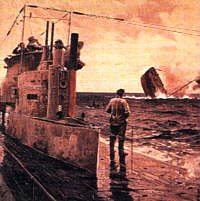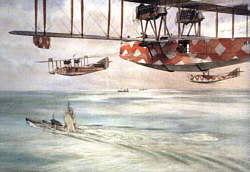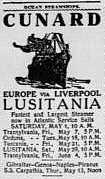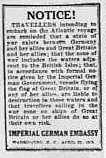
| Back | Armory | Library | Search | Home | Help |
U-boats
Assassins of the Seas
|
|
 | |||||||||||||||||||||||||||||||
| UC 44 Class U-boat: 1) Aft torpedo tubes 2) Electric motor 3) Main engine 4) Control room 5) Mine tubes 6) Forward torpedo tubes 7) Crew quarters | |||||||||||||||||||||||||||||||
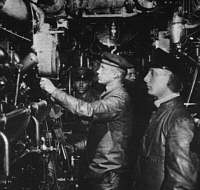 |
Inside the cramped control room. The clean shaven crew is an indication that this photo was taken dockside and not at sea. | ||||||||||||||||||||||||||||||
|
Submarine command organization, 1917
| |||||||||||||||||||||||||||||||
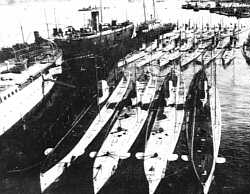 |
U-boats lined up at the docks. Pens were not required since there was no chance of air attack. The fleet reached its peak in 1917 when 146 U-boats were on patrol. Not enough to fulfill the objective of unrestricted submarine warfare. | ||||||||||||||||||||||||||||||
Phases of the U-boat CampaignThe U-boat campaign can be broken into two distinct phases. The first was aimed at allied surface warships; The second, and ultimately more successful, was targeted towards allied shipping - using the U-boat as a tool to enforce an embargo. Early in the war efforts were almost exclusively concentrated towards surface warships with the results looking promising. On 22-Sep-1914 the U 9 under command of Kapitanleutnant Otto Weddigen sank the British light cruisers Abourkir, Hogue and Cressy in the English Channel. The problem here is that both sides soon refused to put their warships at risk by cruising the high seas. The great naval build-up of the last decade may have been one of the most monumental wastes of money of all time - both fleets spending the majority of the war at their home bases with the notable exception of Jutland. On 4-Feb-1915 the Germans began their first campaign of submarine warfare aimed at allied and neutral merchant vessels in the waters surrounding the UK. At this point the practice of allowing the crew to disembark before the vessel was sunk (usually by deck gun since torpedoes were conserved if at all possible) was still generally followed. A notorious exception to this rule was the Lusitania, a Cunard passenger liner that was sunk by U 20 under command of Captain Schweiger on 7-May-1915 off the coast of Ireland. 124 Americans were among the 1,198 casualties. (There are more details on the Lusitania towards the bottom of this page) Three more Americans were killed when the U 24 sunk the Passenger liner Arabic on 19-Aug-1915. The American government brought pressure to bear on Germany and demanded an end to sinking without warning. On 30-Aug-1915 Germany prohibits further action of this type. On 18-Sep-1915 the Germans, in an attempt to reduce further damage to American shipping, withdraw all U-boats from the English Channel area. U-boat activity would be at a lull for the next several months. 1916 would see this lull come to an end. On 13-Mar-1916 the German military issued orders which loosened its stance on sinking without warning. Their U-boat commanders would be able to fire on British ships in home waters as long as they did not appear to be of the passenger variety. The UB 29 violated this convention by sinking the passenger liner Sussex on 24-Mar-1916 which once again resulted in American loss of life. On 24-Apr-1916, for the second time, U-boat commanders are instructed not to sink without warning. This was done amid threats of America breaking off diplomatic relations with Germany. None the less, allied and neutral losses continued to climb throughout the second half of 1916, rising from 37,000 tons in Jun-1916 to 180,000 tons by Dec-1916. By 1917 the situation was getting difficult for Germany. While the U-boat enforced embargo was proving to be an effective weapon, it also seemed that it would bring America into the war against Germany. The only hope now, it appeared, was to increase U-boat activity in an attempt for victory over Great Britain before America could get into the European picture. On 1-Feb-1917 Germany declares unrestricted submarine warfare for the third time. This action causes the United States to break off relations on 3-Feb-1917. The submarine, the weapon that had proven itself most useful in the war on commerce, had now sealed the fate of Germany by swinging the Great Neutral to the allied cause. America declares war on Germany on 6-Apr-1917. U-boat activity intensified greatly in the first half of 1917 with British losses at 300,000 tons in Feb-1917, climbing to half a million by Jun-1917. This period marked the zenith for U-boats. The coming of the convoy system and other anti-submarine tactics would curtail British losses (never to rise beyond 100,000 tons per month) and would transform the predator into prey.
| |||||||||||||||||||||||||||||||
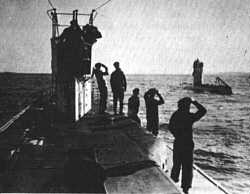 |
View from the deck as two U-boats are about to pass on patrol. | ||||||||||||||||||||||||||||||
The following communique, filed by General von Nagel, sums up the German belief that unrestricted submarine warfare will hasten the end of the war.
M. Kr. 1830
Royal Bavarian Military Plenipotentiary to the War Minister
Subject: Submarine Warfare
No. 6577 GHQSM 5.3.16
A Conference between Chancellor von Bethmann-Hollweg, Chief
of the Naval Staff Holtzendorff and von Falkenhayn.
The Navy believes that the war can only be ended, if it becomes
so unpleasant for Britain herself that she will be inclined to make
peace. Britain cannot be brought this far by land warfare alone.
Therefore it is necessary to attack her with every possible means of
sea and air warfare. Among these means is unrestricted submarine
warfare which must cut off food supplies to Britain without consid-
eration for the trade, etc., of neutrals. [The Navy believes it has
enough submarines and claims that it is now time to attack because
this is the time when grain is shipped to Britain. The Navy also
hopes that the resumption of unrestricted submarine warfare will
bring the British Navy to battle.] ... and that there will then be an
opportunity to inflict a decisive blow upon the English fleet.
So far his Majesty, the Emperor, has apparently not decided
whether or not to accept the suggestions of the Navy. The Imperial
Chancellor's and the Foreign Office's apprehensions that by waging
ruthless submarine warfare we would cause America, the Nordic
States and also Rumania to declare war against us and their belief
that this must be avoided still provide opposition to the plans of the
Navy.
I do not know what the attitude of the Chief of the General Staff
is; the Minister of War, Wild von Hohenborn, whose military views
the Chief of the General Staff values, is said to have expressed
himself very positively in favor of a more intensive conduct of the
war.
| |||||||||||||||||||||||||||||||
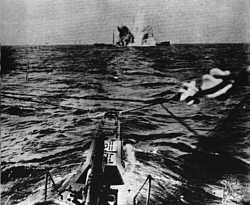 |
View from the tower as a torpedo hits home on a merchant ship. | ||||||||||||||||||||||||||||||
|
Allied and neutral ships lost during the war
Table from The World War I Source Book by Philip J. Haythornthwaite | |||||||||||||||||||||||||||||||
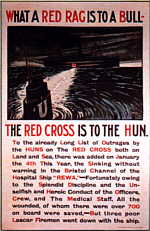 |
the Red Cross is to the Hun. To the already long list of outrages by the Huns on the Red Cross both on land and sea, there was added on January the 4th this year, the sinking without warning in the Bristol Channel of the hospital ship "Rewa". Fortunately owing to the splendid discipline and the unselfish heroic conduct of the officers, crew, and the medical staff, all the wounded of whom there were over 700 on board were saved. But three poor Lascar fireman went down with the ship. Pure fabrication, but effective propaganda none the less. | ||||||||||||||||||||||||||||||
Anti-submarine WarfareCombating the menace of the U-boat was high priority for the island nation of Great Britain. The sea was her supply line and the ships that brought the supplies must be allowed safe passage if she were to stay in the war. The Q-ship was an early attempt to solve the problem of battling a hidden enemy. These ships were converted merchant vessels concealing large deck guns. The practice of allowing the crew to disembark before sinking would lure the U-boat to the surface at which point it would be sunk before it could retaliate against its target. While this may have been effective, it only worked when the U-boat was willing to play fair, that is to say before the Germans caught on. These decoy tactics are largely responsible for the German orders to sink without warning. The next advancement was the hydrophone. This device allowed destroyers to locate submerged U-boats by detecting the sound of its engines and propeller. While it worked to some degree, it did not work as well as hoped. There are many engines and many propellers in a convoy and it can be difficult to determine which is friendly and which is enemy. SONAR and ASDIC were both introduced towards the end of the war. They were much more effective, sort of an underwater form of RADAR, but introduced too late to have much impact. Next came the depth-charge which was introduced in 1916. This is an industrial drum filled with explosives and fitted with a pressure sensitive fuse that causes the device to detonate at a predetermined depth. Its appearance gave it the nickname ashcan. This device also had pros and cons. A major con was that you had to have a fairly good idea of the depth at which your foe was hiding. A pro was that sometimes "close enough" counted. A nearby detonation would collapse the hull of the U-boat due to water pressure and thin hull. By the end of the war the depth-charge accounted for 29 kills - second only to the mine. The mine was a very effective weapon for use both by and against U-boats. U-boats, such as the UC 44 class pictured above, were capable of deploying up to 18 mines while out on patrol. Mines were employed against U-boats in confined areas such as the English Channel. They kept entire harbor areas off limits to U-boats - a very good preventative weapon. The final two tactics were effectively combined in the later years of the war - the convoy and air coverage. Allied shipping losses were cut by a fifth in mid 1917 when the convoy system was adopted by the British Navy at the urging of Prime Minister Lloyd George. Merchant ships would be massed together for the crossing and given a destroyer escort. While it did not eliminate losses, it certainly brought them down to a manageable and replaceable level. The entire American Expeditionary Force was delivered to Great Britain with the loss of 1 ship, 100 troops - an amazing fact considering the distances and number of men involved. Only the stragglers became suceptable. Air coverage was added to the convoy system in 1918 and results were dramatic: only 5 ships were lost under the protection of air coverage. | |||||||||||||||||||||||||||||||
| |||||||||||||||||||||||||||||||
|
The story behind the sinking of the Cunard passenger liner Lusitania has been enveloped in controversy since the day of its occurrence. The story is an interesting one. The Lusitania was launched 7-Jun-1906. The luxurious liner was 760 feet long with a beam of 87.5 feet and had a displacement of 45,000 tons. It had a cruising speed of 25.88 knots. On its first run in Sep-1907, it recaptured the coveted Blue Riband (fastest Atlantic crossing) from the German liner Kaiser Wilhelm II. One of its design innovations was to store 6,600 tons of coal required for a crossing, in longitudinal bulkheads between the inner and outer hulls. It was originally thought that this would provide protection should the ship ever come under attack, a concept that would later prove to be very wrong. In 1913 the Lusitania was drydocked and outfitted with twelve 6-in guns. This was done as a precaution should there be a war with Germany. When it sailed in Sep-1914 it was registered as an auxiliary cruiser. In addition to this it also violated international law by carrying munitions on all but its first wartime crossing. When it embarked for England on 1-May-1915 its cargo included: 51 tons of shrapnel shells, 10.5 tons of .303 caliber rifle bullets, and an indeterminate amount of guncotton, an explosive that detonates upon contact with water. It also picked up some 200 tons of additional ammunition from the Queen Margaret who was undergoing mechanical difficulties. Despite a printed warning from the German Embassy, only one passenger changed his travel plans. At 1:35 pm GMT on 7-May-1915 off the coast of Ireland Captain Schweiger, commanding the U 20, fired his last torpedo at the Lusitania. He didn't expect the single torpedo to sink the liner, he just wanted to see how much damage it would do. The G-type torpedo hit just forward of the bridge on the starboard side. The initial explosion of the torpedo warhead was followed by a much larger one that shook the entire ship. Eighteen minutes later the giant liner was gone. 1,198 people perished, among them 124 Americans. The Germans justified this action by claiming that the Lusitania was far from an unarmed merchant ship, and while deploring the loss of life, claimed the U 20 was acting in self-defense. In an attempt to placate the United States government the Germans accepted liability for the incident in Feb-1916 and agreed to pay reparations. | |||||||||||||||||||||||||||||||
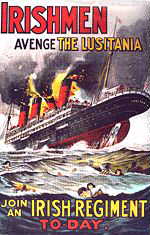 |
The sinking of the Lusitania was a propaganda bonanza for the allies. Posters such as the one at left , exploit the disaster to the fullest. This incident, coupled with the German atrocities in Belgium, would bring the United States in on the allied side in 1917. | ||||||||||||||||||||||||||||||
| Back | Armory | Library | Search | Home | Help |
